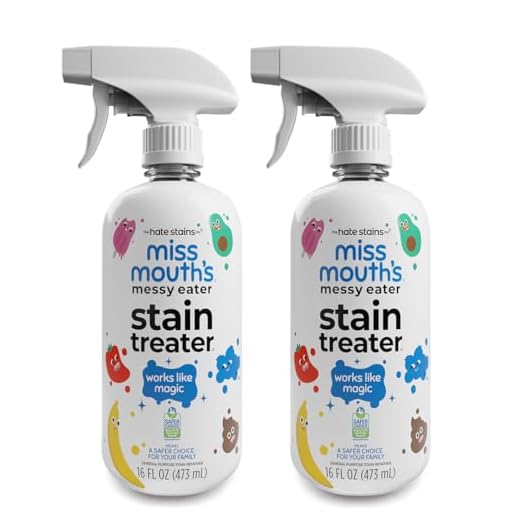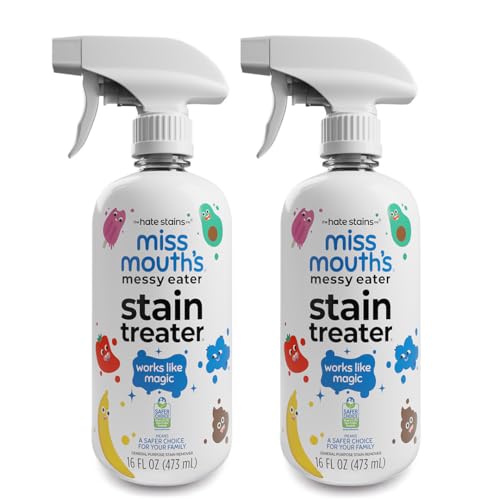



Act quickly with cold water. Blot the affected area gently, avoiding vigorous rubbing that may worsen the situation. After the initial treatment, sprinkle a generous amount of salt or baking soda to absorb the excess liquid. Allow it to sit for about five minutes, then carefully brush off the residue.
Next, consider a solution of equal parts vinegar and dish soap. Apply this mixture directly to the blemish, letting it penetrate for approximately 30 minutes. Rinse thoroughly with cold water afterward. For persistent marks, a paste made from hydrogen peroxide and dish soap can be applied. Leave it for a short period, then rinse thoroughly.
Always test any solution on a hidden area first to ensure colorfastness. When in doubt, consulting a professional cleaner is a reliable approach to preserving the integrity of the fabric.
Stain Treatment Techniques for Textiles
Act quickly! Blot the affected area with a clean cloth to absorb excess liquid. Avoid rubbing, as this can push the pigment deeper into the material.
Common Methods
Utilize salt as an absorbent by generously sprinkling it on the area. Let it sit for several minutes before rinsing with cold water. This technique can prevent a permanent mark.
Another effective solution involves white vinegar and dish soap. Mix equal parts of both, apply to the spot, and gently blot. Rinse thoroughly afterward.
Advanced Approaches
For stubborn discolorations, a paste of baking soda and water works wonders. Apply the paste to the mark, allow it to dry, then brush off the residue and rinse.
Consider using commercial stain removers specifically designed for pigment challenges. Follow the instructions meticulously for the best outcomes.
| Method | Materials Needed | Steps |
|---|---|---|
| Salt Treatment | Salt, clean cloth | Blot, apply salt, wait, rinse |
| Vinegar and Soap | White vinegar, dish soap | Mix, apply, blot, rinse |
| Baking Soda Paste | Baking soda, water | Mix, apply, dry, brush, rinse |
| Commercial Remover | Stain remover | Apply, follow instructions |
Rinse thoroughly after each method to ensure no residue remains, which can lead to further discoloration. Always test any solution on a hidden area first to avoid damage.
Act Quickly: The Importance of Immediate Action
Immediate intervention is key to minimizing the impact of a deep crimson liquid on textiles. As soon as the spill occurs, blot the area gently with a clean cloth or paper towel. Avoid rubbing, as this can push the liquid further into the fibers. Instead, focus on absorbing as much of the liquid as possible.
Utilize Common Household Items
After blotting, apply a mixture of cold water and a small amount of dish soap directly to the affected area. This mixture can help lift the pigment from the fabric. It’s important to act swiftly, as the longer the pigment remains, the harder it becomes to eliminate.
For more stubborn remnants, consider using salt or baking soda as absorbent agents. Sprinkle them over the spill after blotting, allowing them to sit for several minutes before rinsing with cold water.
Seek Professional Solutions
If the situation persists despite home remedies, don’t hesitate to consult a professional cleaning service. Their expertise can often resolve issues that at-home methods cannot. Keeping textiles in prime condition is essential for longevity.
In the meantime, if you’re looking to enhance your culinary skills, check out this link on how to cook a beef chuck shoulder steak for a delicious pairing with your favorite wines.
Blotting Techniques: How to Minimize Stain Spread
Utilize a clean, dry cloth or paper towel to gently dab the affected area. This action absorbs liquid instead of rubbing, which can spread the discoloration further. Employ a light touch; pressing too hard can push the pigment deeper into the fibers.
Always work from the outside edge of the mark toward the center. This approach prevents the stain from expanding outward. Rotate the cloth frequently to maximize absorption and avoid reapplying the liquid to the fabric.
Material Selection
Choose an absorbent material, like cotton, for blotting. Avoid using colored fabrics, as they may transfer dye onto the surface. White or light-colored paper towels are ideal for monitoring the amount of liquid being absorbed.
Technique Refinement
For optimal results, alternate between blotting and applying a small amount of cold water to the area. This can help dilute the color without causing further damage. Maintain a consistent approach, as persistence is key in mitigating the impact of the liquid.
In cases of stubborn discoloration, consider using a clean, damp cloth after initial blotting to lift any remaining pigment. Remember, the goal is to absorb rather than scrub, preserving the integrity of the material involved.
Common Household Remedies: What to Use and How
White vinegar and dish soap create a potent mixture for tackling discolorations. Combine one cup of white vinegar with one cup of water and two tablespoons of dish soap. Apply this solution to the affected area, gently scrubbing with a cloth until the mark fades.
Baking Soda Paste
Baking soda serves as a gentle abrasive. Mix three parts baking soda with one part water to form a paste. Apply this paste to the impacted area and allow it to sit for about 30 minutes before rinsing. This method can lift the pigment without damaging the material.
Seltzer Water Solution
Carbonated water can aid in loosening the color. Pour seltzer directly onto the area, letting it fizz and bubble for a few minutes. Blot with a clean cloth to absorb the liquid and pigment.
- Club soda can be a great alternative to seltzer.
- Hydrogen peroxide diluted with water can also be effective, but test on a hidden section first to ensure it doesn’t discolor the textile.
- For delicate materials, opt for a professional cleaning solution specifically designed for such fabrics.
Always remember to perform a patch test with any remedy to check for adverse reactions before applying it to the entire area. Consistency in blotting and avoiding rubbing the fabric can significantly enhance results.
Stain Removal Products: Choosing the Right One
Select a specialized stain remover formulated for tannin-based discolorations. Products containing enzymes or oxygen bleach effectively break down pigments, making them ideal for tackling challenges associated with dark liquids.
Consider pre-treatment sprays that penetrate fibers. These are designed for targeted application, enhancing the efficiency of subsequent washes. Always follow the manufacturer’s instructions for optimal results.
For those preferring natural solutions, look for options containing citric acid or baking soda. Both have proven efficacy against tough marks, providing a safe alternative to harsh chemicals.
Test any product on an inconspicuous area before widespread use. This step ensures compatibility with the material, preventing damage or discoloration during the cleaning process.
Once a suitable product is selected, apply it generously to the affected area, allowing it to sit for the recommended duration. This soaking time is critical for breaking down the pigments effectively.
After application, rinse thoroughly with cold water. Ensure that all residues are removed before laundering, as leftover chemicals can lead to further issues in the wash cycle.
For persistent marks, repeating the treatment may be necessary. Persistence often pays off in achieving a spotless outcome.
Washing Instructions: Best Practices for Cleaning Fabric
Begin with cold water, as hot temperatures can set the mark deeper into the material. Rinse the affected area under cold running water to dilute the residual liquid. Avoid scrubbing; this can cause the pigment to spread further.
Machine Washing
- Check care labels for washing instructions.
- Use a gentle cycle to prevent damage to fibers.
- Add an appropriate stain-fighting detergent specifically designed for tough marks.
Hand Washing
- Fill a basin with cold water and a mild detergent.
- Submerge the fabric, gently agitating the water to loosen debris.
- Rinse thoroughly with cold water until all soap is removed.
For persistent discolorations, consider soaking the material in a solution of cold water and a specialized cleaning agent for up to 30 minutes before washing.
Always air dry after cleaning; heat from a dryer can set any remaining traces. If necessary, repeat the washing process until the mark is eliminated.
Preventive Measures: Tips to Avoid Future Stains
Opt for darker-colored tablecloths when hosting gatherings. This choice can effectively conceal any accidental spills, making it easier to maintain a clean appearance.
Use protective sprays designed for fabrics. These products create a barrier that helps repel liquids, providing an additional layer of defense against potential blemishes.
Encourage guests to be mindful while pouring. Position wine bottles in a way that minimizes the risk of drips or splashes, and consider using pour spouts to control the flow.
Provide coasters and napkins at every setting. This simple addition can absorb spills before they reach the surface, reducing the chances of permanent marks.
Store wine bottles upright when possible. This technique helps prevent leaks and ensures that corks remain intact, minimizing the risk of any unwanted accidents.
Regularly clean and maintain your fabrics. Establish a routine that includes washing and treating textiles, as this can enhance their resistance to stains over time.
Educate guests about proper wine handling. Sharing tips about careful pouring and drink placement can foster a more conscientious environment, ultimately reducing mishaps.
FAQ:
What is the best way to treat a red wine stain on fabric immediately after it occurs?
To treat a red wine stain on fabric right after it happens, quickly blot the stain with a clean cloth or paper towel to absorb as much wine as possible. Avoid rubbing, as this can spread the stain further. After blotting, sprinkle salt or baking soda on the stain to absorb the wine. Then, rinse the area with cold water. If the fabric is machine washable, launder it as soon as possible with a stain remover or a mixture of dish soap and hydrogen peroxide.
Are there any home remedies that can effectively remove red wine stains from fabric?
Yes, there are several home remedies that can be effective for removing red wine stains. One popular method is to use a mixture of white vinegar and dish soap. Combine one part white vinegar with two parts dish soap, apply it to the stain, and let it sit for about 30 minutes before rinsing with cold water. Another option is to use club soda; simply pour it over the stain, which can help lift the wine out of the fabric. After treating with either method, washing the fabric according to its care instructions is recommended for best results.







